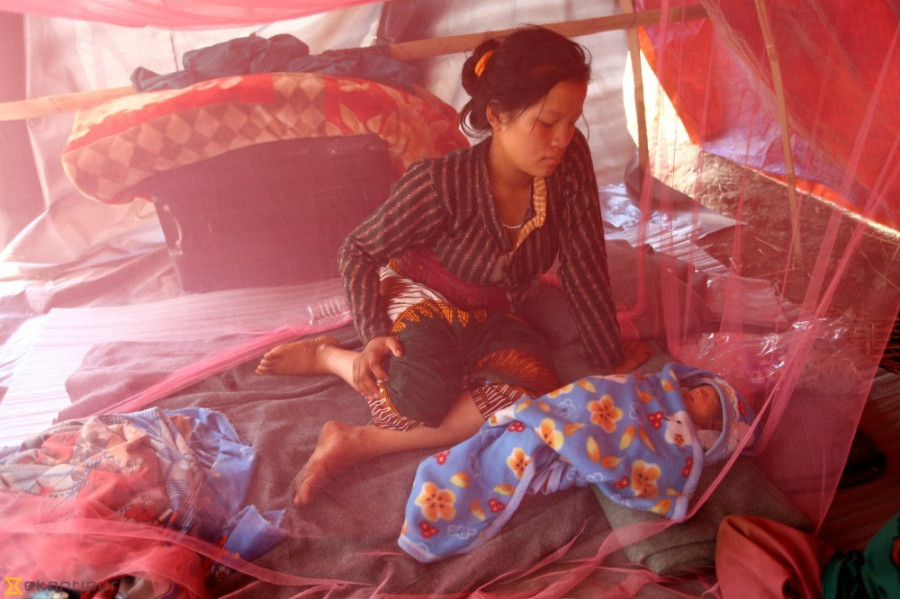Health
Debunking maternal healthcare myths
Traditional methods of care have been passed on through generations, but are they actually beneficial?
Sachitra Gurung
Seti Maya Lama was 20 years old when she gave birth to her first child at her home in Thaprek, Tanahun. She recalls having just reached home from the fields when her water broke. In her village, people usually sought the help of traditional midwives—called sodinis—during childbirth, but during her first child’s birth, her mother-in-law took the midwife's place instead.
“That was how I gave birth to all my children,” says Lama, who went on to become a mother to 10 children and is now 86 years old.
According to Lama, back in those days, everyone used to give birth at home under the supervision of traditional midwives and no one really visited hospitals during pregnancy, for deliveries or postnatal care—they did what they were told to do by their elders.
But since then, maternal health care and neonatal health care has drastically changed in Nepal. Under the safe motherhood programme by the Department of Health Services, which was revised in 2005, incentives are provided to women who opt for institutional delivery and complete four antenatal checkups during the fourth, sixth, eighth and ninth months of pregnancy—in a bid to improve maternal and neonatal healthcare and decrease maternal and neonatal morbidity and mortality rate.
However, despite there having been a lot of awareness campaigns regarding maternal health in the last decade, only 58 percent of deliveries were conducted by skilled birth attendants, and 57 percent of deliveries took place in a health facility according to Nepal Demographic and Health survey in 2016. Out of which, only 57 percent of both mothers and newborns received postnatal care within two days of delivery.
But for further postnatal care, many in Nepal still rely on traditional methods—both in rural and urban areas. These methods are passed down through generations based on the experience of elderly women in the family.
During her time, Lama says new mothers ate jwano ko jhol (thyme seed broth) and lots of meat, wore patuki around their stomach, and both baby and mother were given oil massages every morning and evening.
Many of these methods are reinforced by medical professionals as well but they advise new mothers to check with their doctors beforehand to avoid any harmful consequences.
Prajita Mali, 33, who gave birth to her first child last year says her diet too mainly consisted of jwano’s soup, meat and ghee.
The traditional diet also gets a nod from Dr Nira Singh Shrestha, Head of the Department of Obstetrics and Gynaecology at Nepal Mediciti hospital.
“New mothers are given jwano’s soup to increase their breast milk supply. It is in our tradition but it has also been proven by science. Similarly, wearing patuki helps compress the bulging stomach after giving birth and also helps with back pain,” she says.
But she says the ongoing antenatal trend where pregnant women are encouraged to rest is not beneficial at all.
“In the case of normal pregnancy, women should carry on with their everyday chores. Of course, lifting heavy objects and doing physically and mentally exhausting work should be discouraged, but they should not be sitting idle,” says Shrestha. “It will only make her body weaker.”
According to Lama, avoiding any physical activity during pregnancy is a recent trend and was not advised to her when she was carrying her baby.
“Nowadays pregnant women do not work and just rest, even my daughters did that, but I never stayed idle during my pregnancy. My mother-in-law let me carry gagri and huge utensils and that’s about it,” she says.
However, Shrestha adds, it is not wise to generalise all pregnancy cases. “Sometimes cases are complicated, which may require pregnant women to take complete bed rest,” she says. “There are particular exercises designed to help pregnant women according to each case, that's why it's important to seek professional care.”
Furthermore, she says there are various myths regarding food consumption in pregnant women. “Pregnant women are advised to not eat hing, timmur, pineapple, but there aren’t any findings to back it up. There are only a few food items that aren't suitable for pregnant women like raw papaya, mercury and lead-containing sea fish and junk food.” There are many traditional postnatal practices that are proven to be harmful for both the mother and baby, according to her. “Science doesn’t support bathing the baby immediately after birth. The newborn isn't used to the outside temperature, so it's best to bathe the baby after 74 hours, otherwise the baby can suffer from hypothermia and pneumonia,” says Shrestha.
However, she approves of traditional oil massages and says that they are the best for the baby and mother as it makes the baby stronger and also relaxes the new mother. But during oil massages, warming up the room by burning coal can land the baby in an emergency room if proper measures, like ventilating the room, aren’t taken care of.
Many new mothers like Mali, especially in urban areas, have begun to question such traditional practices or at least take a professional opinion before using them on their babies. “I consulted with my doctor regarding these practices before actually following them,” says Mali.




 8.12°C Kathmandu
8.12°C Kathmandu














